Table of contents
Getting Started with Budgets
Thursday February 15, 2024-15 min readUnderstanding your organization’s finances is not just crucial; it’s the cornerstone of sustainable success and growth. With Appward’s Budgets app, you gain access to a comprehensive suite of features designed to empower you in every aspect of financial management. From creating and monitoring budgets to analyzing spending patterns and forecasting future trends, our app provides you with the insights and tools necessary to make informed decisions that drive your organization forward.
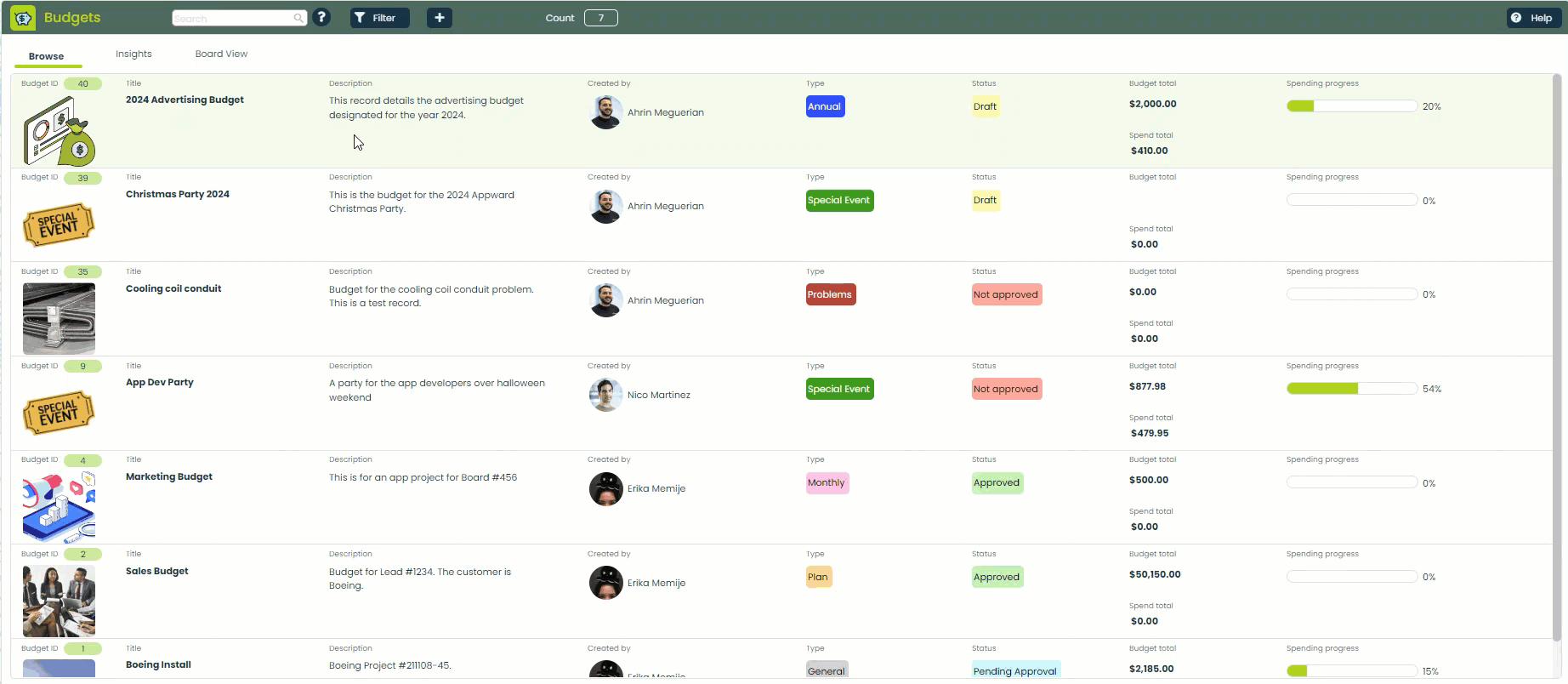
Let’s get started
To access the Budgets app, navigate to the Operations category in the main navigation bar and select Budgets.
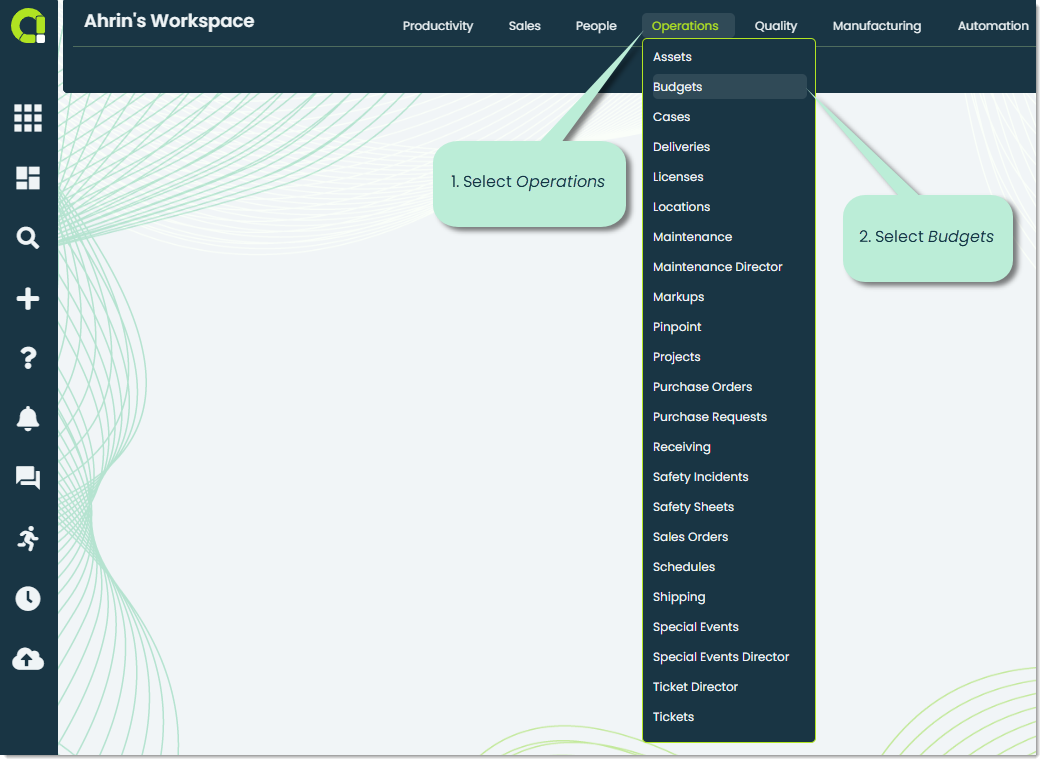
When you open the Budgets app, the first thing you’ll see is the Browse tab. This is the main tab of the app where you can view all of your organization’s created budgets. You’ll notice there are two other main tabs, let’s go over their purpose.
Note: If this is your organization’s first time using this app, this screen may be empty.

Insights – The Insights tab is where you can analyze data from your organization’s Budgets. Using Insights, have the opportunity to uncover and make use of valuable information related to Budget types, status, spending, and more. For more on Insights, please check out our Getting Started with Insights guide.

Board View – This tab shows a Kanban-style display of your organization’s budgets, grouped by the stage they are in.
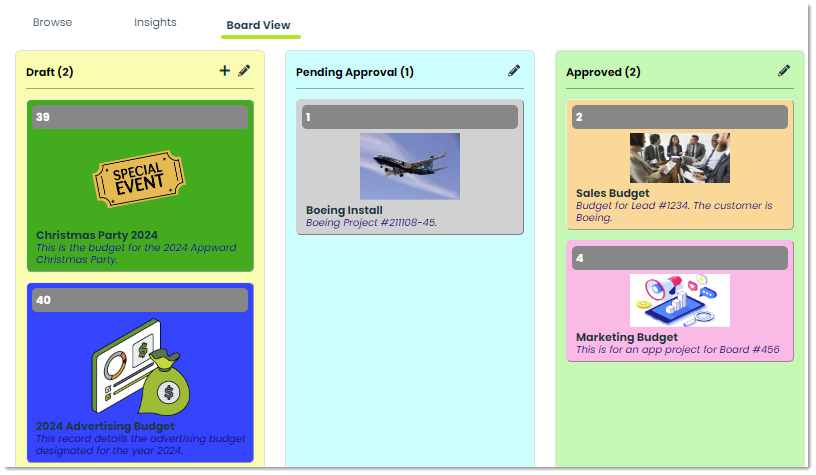
How to add a budget
To add a new budget, click on the + icon at the top of the app screen.
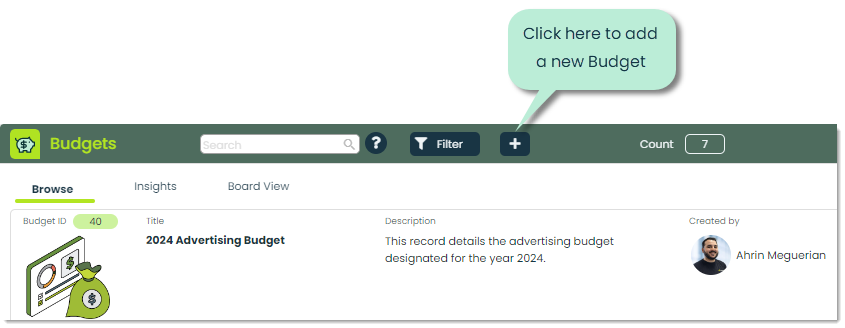
Upon selection, you’ll be prompted with the Add budget popup, enabling you to commence defining the specifics of the budget you’re about to create. Let’s go over the available fields in the add process.
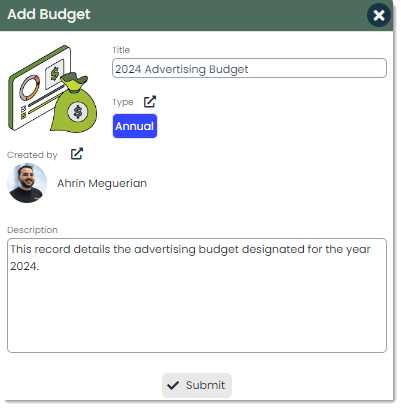
Title – This is where you can fill in the title for your budget.

Image – You can improve your budget record by associating an image with it. This image will be visible when viewing and managing a budget.

Type – You can categorize the budgets you create by the Type you assign to them. Types appear as labels with custom names, colors, and images that can be directly associated with records throughout all of Appward. You can organize your data in a fully flexible, customized way to suit your business. As an example, a budget associated with advertising that is allocated yearly, could be categorized by the type “Annual.” For more information on Types, please check out our article Using Types.

Created by – In Created by you can identify the person who is responsible for creating the budgets record. By default, the creator’s details will automatically populate in this field. However, you have the option to modify this and assign the record to another contact within your organization if you are creating it on behalf of someone else.

Description – The Description field is where you can provide the details regarding the budget’s parameters and objectives.

Submit – Once you have finalized the initial details of your budget, simply press the Submit button to generate the record.

Viewing and managing budgets
After you have created a budget, you can view and manage it by navigating to the Browse tab and clicking on the desired record.

This will bring up the budget’s details flyout, where you can view important details as well as edit and manage the budget as you need to.
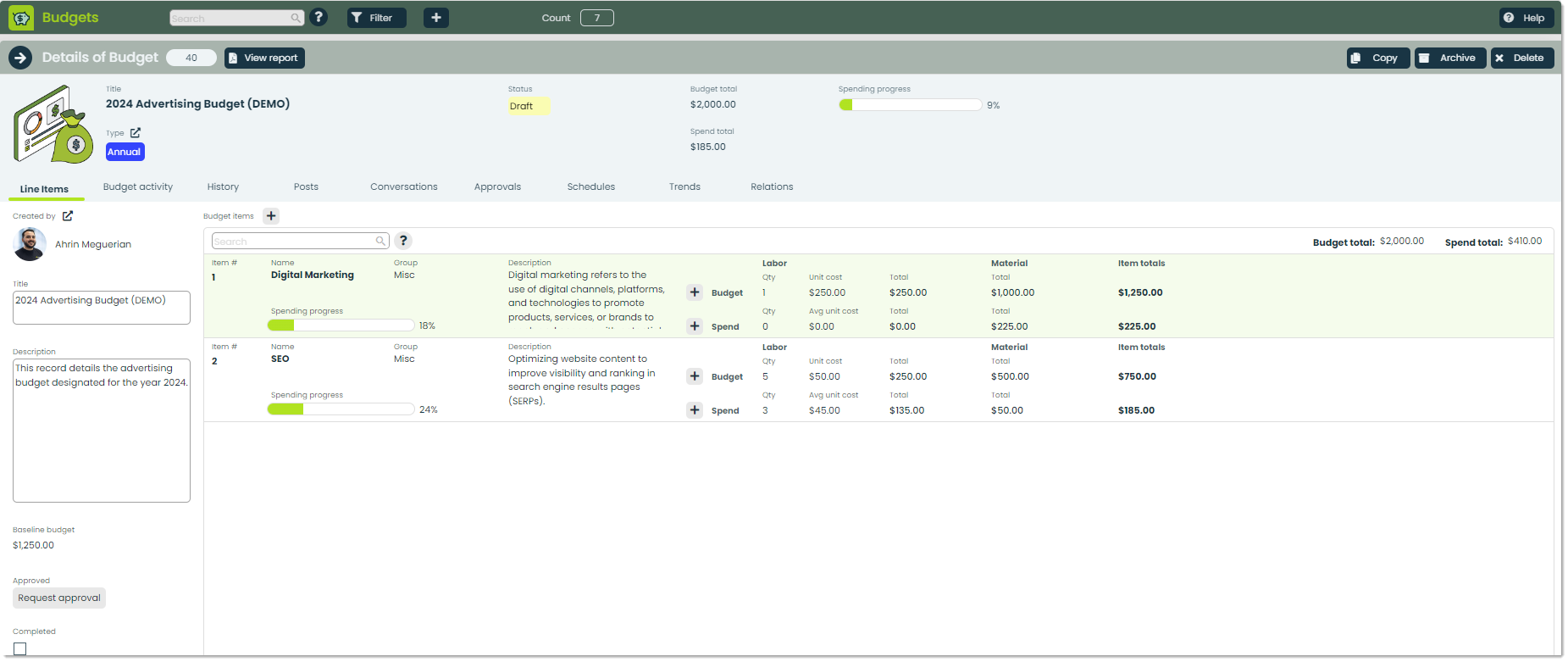
Baseline Budget – Setting a baseline budget for your business serves as a fundamental way to create your financial blueprint, outlining projected income and expenditures. Having a baseline budget is important in guiding your organization in financial planning, decision-making and optimizing resource allocation.

Pressing the Set baseline button will bring up the Set Baseline Budget popup, providing you with the option to establish the current budget as the baseline. This feature allows you to make informed decisions about whether to align your current budget with the baseline for comparison and analysis purposes. If additional approval is required from upper management, you can check the box for Request approval to signal to your organization that additional approval is required to set the baseline budget.
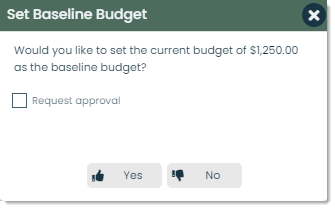
Completed – When a budget record has been completed and will no longer be used, you can tick the checkbox in the Completed field, indicating that no further modifications will be made.

Add Budget Item – As you manage an allocated budget, it’s important to be able to log and track values accurately. You can add budget items by pressing the + icon directly next to the Budget items caption.

This will bring up the Add budget item popup, where you can add individual items that pertain to the allocated budget.
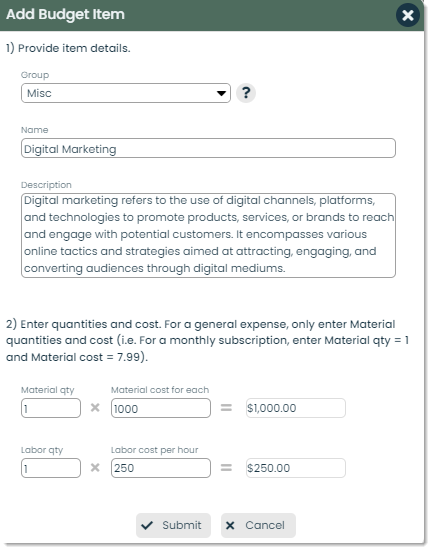
Group: The group this budget item falls under. This can be thought of as a topic as well.
Name: The name of the budget item.
Description: A description of the budget item, giving the reader an idea of what exactly the budget entails.
Quantities: The total dollar amount of each material quantity or labor quantity required.
After adding the budget item, you can view and modify its details within the pane.

Viewing budget activity
To view the changes made to budget line items, navigate to the Budget activity tab.

This feature shows you the same information as the Line Items tab but in reverse order, with the newest changes at the top. It gives you a timeline of recent activities.
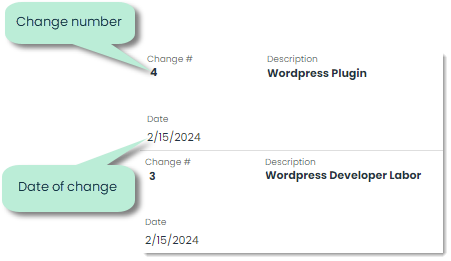
Using budgets in other apps
Budgets are built into many of the apps in the Appward ecosystem. A good example of this is how it is integrated into the Suggestions app.
Let’s take a look at the details of a Suggestions record.
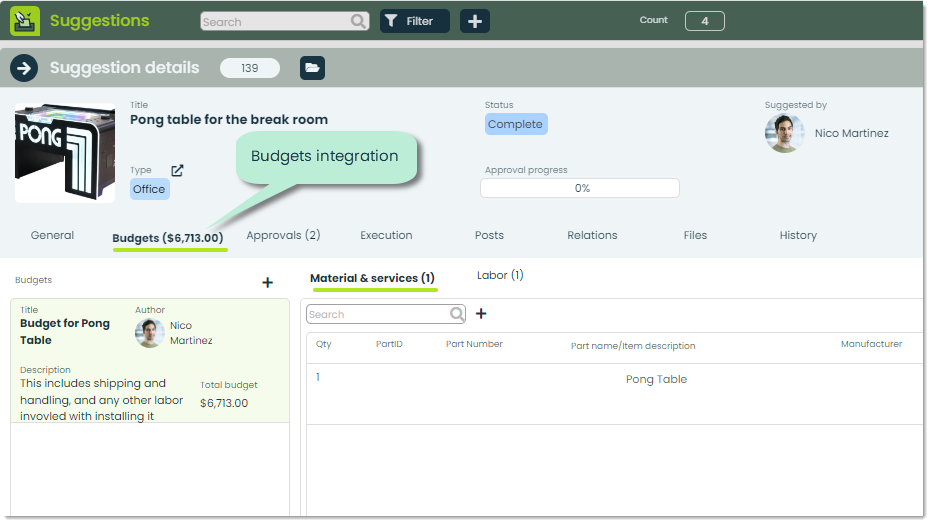
In the Suggestion Details flyout you’ll find a tab named Budgets that offers the same features as the Budgets app but in a simpler format tailored for the Suggestions app. There are a few minor changes to how Budgets is integrated here, so let’s take a look at what they are.
Within the Budgets tab, you’ll notice two tabs.
Materials & Services – This tab is where you can include any materials or services that have a cost associated with them that should be added to the overall budget.

To add a new Material & service, click on the + icon.
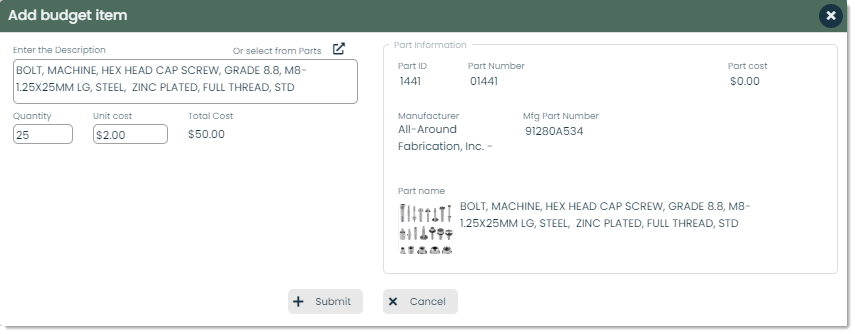
Select from Parts: During the process of adding a budget item related to materials & services, you may want to include an existing part from within your organization. To include an existing part, click on the external link icon and select from a list of parts imported directly from the Parts app.
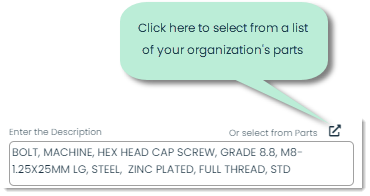
Part Information: In the Part Information section, you can find key details about a part, like its cost, ID number, and manufacturer’s name.
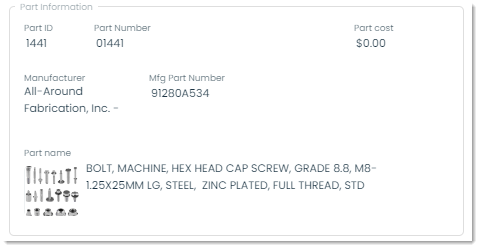
Labor – Just like adding a part to your budget, you may also need to consider additional labor costs that could come up while completing a task. By assigning an hourly rate for the labor, it will automatically factor into the overall budget, giving you an accurate representation of how much it will cost.

To add a new Labor entry, click on the + icon
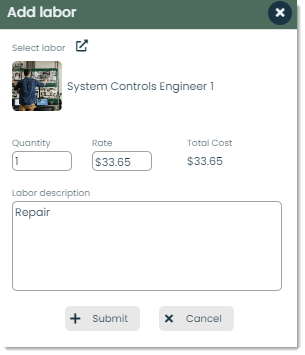
Advanced search and filtering
Efficiently finding the right record is crucial for smooth workflow and task completion. That’s why Appward includes advanced search and filtering in every app on the platform. Let’s look at how you can search for record within the Budgets app.
We’ll use this record as an example:

The following advanced search keywords will bring up this record:
id=40
budgetid=40
title=2024 advertising
budgettitle=2024 advertising
description=budget designated
desc=budget designated
d=budget designated
creator=ahrin
createdby=ahrin
c=ahrin
type=annual
status=draft
s= completed
Furthermore, you have the option to utilize the Filter button, which triggers the Filter selection popup. This popup provides similar functionality to the search bar, along with some additional features.
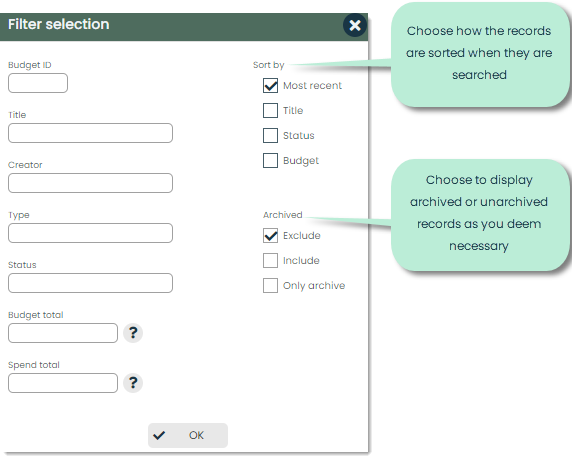
Frontline features of Budgets
History – In History, you can view an activity log related to the Budgets record you are viewing. You will see a list displaying the modifications date, activity description, modification author, and the application in which it was made. This helps you stay on track with what changes have been made to the record.

Posts – In Appward, a post is a comment that can be liked or replied to directly by other members of your organization. Posts are an effective tool for communicating throughout the platform, whether it be within a meeting or in a budget record directly.

Relations – You can include related records from other apps directly in the Relations tab. Simply click on the + icon and click on the record from any app that you wish to associate with the current Budgets record. This is a helpful way of keeping information from different places in a centralized location.

Additional features of Budgets
Help – The Help button can be found in most of the apps in the Appward ecosystem. You can use it as a powerful resource view and learn about helpful information compiled specifically to help guide you through how the app works. Tours are interactive, step-by-step guides that give you an introduction on how to use an app.

Copy – The Copy function instantly duplicates the selected record, making it particularly useful for generating multiple records with similar qualities and details.

Archive – Archiving is a common feature within the majority of apps in Appward. Archive serves as an effective tool when you wish to remove a record from sight without permanently deleting it. Archived records are essentially concealed from the main screen but remain accessible through specific search filters.

Delete – You can delete a budget record by pressing the Delete button. The deleted records will be available for recovery for a maximum of five days within the Deletions app.

